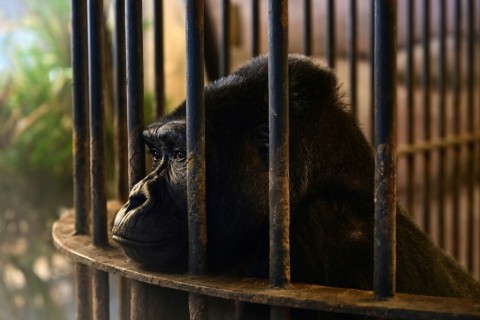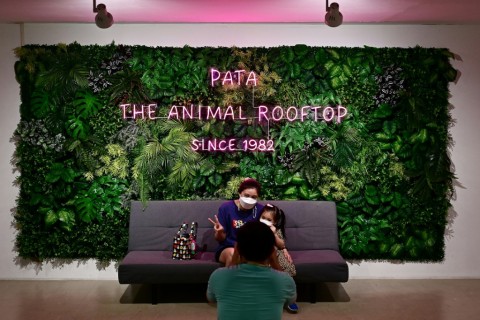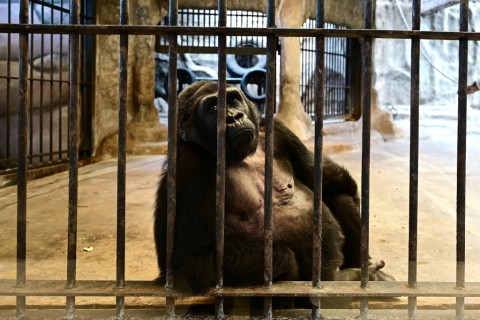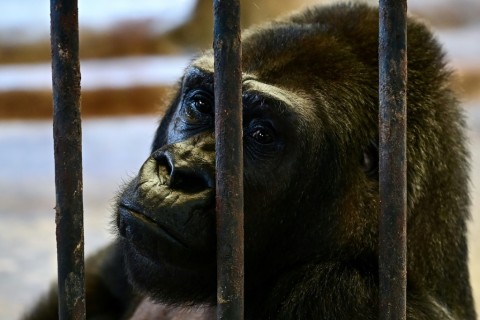Bangkok, Thailand (AFP)
by Rose TROUP BUCHANAN / Thanaporn PROMYAMYAI

Seven storeys above a shopfloor hawking cheap perfume and nylon underwear, Thailand’s “shopping mall gorilla” sits alone in a cage — her home for 30 years despite a re-ignited row over her captivity.
Activists around the world have long campaigned for the primate to be moved from Pata Zoo, located on top of a Bangkok mall, with singer Cher and actor Gillian Anderson adding their voices in 2020.
But the family who owns Bua Noi — whose name translates as “little lotus” — have resisted public and government pressure to relinquish the critically endangered animal.
The gorilla has lived at Pata for more than three decades but her case made headlines again this month after the zoo offered a 100,000 baht ($2,800) reward for information leading to the arrest of whoever graffitied “Free Bua Noi!” on one of the mall’s walls.
The upset comes as Thailand welcomes back tourists after the pandemic, many drawn to the kingdom’s wildlife — and ease of access.
The zoo represents a snag in its shift from a country infamous for tiger selfies and abused elephants, to the kingdom trying to position itself as more environmentally friendly.
Authorities have passed new environmental legislation, mostly targeted at preventing the abuse of native-born animals, and these laws do not necessarily cover privately owned zoos such as Pata — or non-indigenous creatures like Bua Noi.

“(Pata) can still open because the wild animal conservation and protection act zoo section has not been enforced yet,” Padej Laithong, director of the national wildlife conservation office, told AFP.
Animal welfare regulations are monitored at only eight state-linked zoos, and with private facilities, officials are more worried about them fulfilling licensing requirements.
Pata had applied for a licence extension before theirs expired, Padej said, adding he was mostly concerned over the building’s fire safety — not the animals’ welfare.
“All of these details must be answered before the license can be renewed, suspended or revoked,” he said.
– ‘Among her own kind’ –
A representative for Pata Zoo did not return multiple requests for comment.
But the zoo has blamed foreigners for the criticism, noting that zoos around the world house gorillas without problems.
“No citizens of any country in the world have attacked their country for possessing gorillas, except in Thailand,” the management said in a six-page statement published after the graffiti incident.
They said the gorilla has been well-cared for throughout her life, despite the creature costing more to support than she brought in.

Bua Noi was reportedly three years old when she was brought over from Germany in 1992. With the average lifespan of the Eastern Gorilla being over 40 years, according to IUCN, she has spent much of her life at Pata.
“She needs to get out of it,” Edwin Wiek, of Wildlife Friends Foundation Thailand, a sanctuary that aims to educate people and rehabilitate animals, told AFP.
“She is not able to see the sun, the moon. She’s in a cement box with glass windows.”
As international pressure to release Bua Noi grew last year, the family-owned zoo rejected a reported 30 million baht ($880,000) offer from Thailand’s Ministry of Natural Resources and Environment, saying the gorilla was too old to be rehomed.
But activists say this misses the point, insisting that the cage holding the gorilla — a highly sociable animal that would live in tightly-knit family groups in the wild — is unsuitable.
“She needs to be among her own kind, or at least be outside and have some chance to see things, experience nature, birds flying around,” said Wiek.

Other animal rights groups have gone further, with People for the Ethical Treatment of Animals (PETA) — which has staged multiple protests over the years — saying Bua Noi was “suffering from extreme psychological distress”.
Each weekend, children and parents take the rickety lift up to the zoo, eventually climbing out to a rooftop Bua Noi shares with macaques, orangutans and tropical birds.
Scruffy pygmy goats greet visitors before they are directed towards Bua Noi, away from the building dust and debris still dominating much of the zoo.
There the massive gorilla looks set to remain, stuck behind iron bars and glass windows with only a swinging tire for company.







